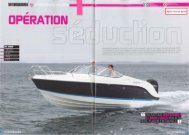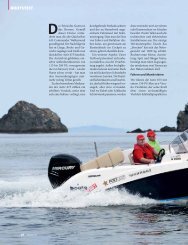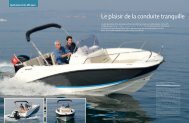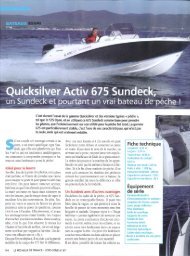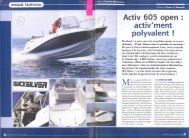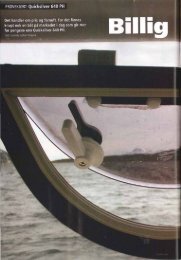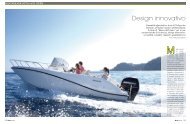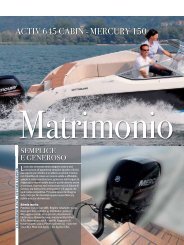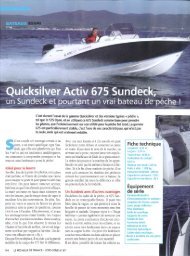Boat Test 640 Pilothouse - Magazine - Quicksilver Boats
Boat Test 640 Pilothouse - Magazine - Quicksilver Boats
Boat Test 640 Pilothouse - Magazine - Quicksilver Boats
Create successful ePaper yourself
Turn your PDF publications into a flip-book with our unique Google optimized e-Paper software.
oat <strong>Test</strong><br />
QUICKSILVER<br />
<strong>640</strong> PILOTHOUSE<br />
PHOTOS JOHN FORD<br />
FLEET<br />
O’ FOOT<br />
It looks like an Arvor, feels like an Arvor<br />
but unlike an Arvor it goes decidedly<br />
quicker. JOHN FORD investigates this<br />
new <strong>Quicksilver</strong> <strong>640</strong> <strong>Pilothouse</strong> on its<br />
maiden voyage<br />
86 tradeaboat.com.au The boat you want is now easier to find tradeboats.com.au 87
BOAT<strong>Test</strong><br />
The 150hp Mercury four-stroke is a<br />
favourite of mine and it delivered<br />
power down low and revved<br />
willingly to give a top-end speed of<br />
nearly 36kts – around 16kts more<br />
than the diesel version<br />
very European in style and high<br />
out of the water at the gunwales.<br />
Despite generous head-height the<br />
cabin remains well-proportioned<br />
and having the cabin floor set low<br />
in the boat – you step down into<br />
it – allowing the roofline to stay in<br />
proportion.<br />
Narrow walkways either side of<br />
the cabin lead forward to a sturdy<br />
bowsprit and an industrial-strength<br />
stainless steel bollard on the cabin<br />
top. There is a horizontal Lofrans<br />
electric winch feeding chain and<br />
rode to a cavernous well with a<br />
moulded fibreglass hatch. It’s all<br />
very neat and it leaves plenty of<br />
room for a couple of people to fish<br />
up front and another along the<br />
walkway, all protected by a rail that<br />
runs back amidships.<br />
Minimalist dash is a carryover from<br />
Arvor, however the helm seats are<br />
surprisingly comfortable and V-berth<br />
seating (with chemical loo) converts<br />
to bunks for overnight stays and<br />
weekends away.<br />
There are many nice things<br />
you could say about an<br />
Arvor: roomy, stable,<br />
practical and versatile<br />
are all appropriate<br />
descriptions. However, to describe<br />
the company’s rock-solid perennial<br />
performers as pulse-quickeners<br />
would be a stretch. It’s just not what<br />
they are about.<br />
All this is relative of course and<br />
Arvor’s many owners enjoy the<br />
leisureliness – embrace it even. The<br />
payback is a seaworthy boat that<br />
runs on the smell of an oily rag.<br />
Some would argue that in a seaway<br />
it’s not often that speeds of more<br />
than 20kts are attainable anyway<br />
and an Arvor could chug halfway<br />
to New Zealand on a tank at such a<br />
pace you could comfortably nibble<br />
daintily on French pastries and sip<br />
an early morning latte.<br />
Peter Collins has been importing<br />
Arvor boats for years but even he<br />
confessed quietly that people at<br />
boat shows, enamoured with the<br />
Arvor concept, have asked if he had<br />
something just a little bit faster. Well<br />
hello <strong>Quicksilver</strong>!<br />
Arvor is now part of the enormous<br />
Brunswick Corporation, which also<br />
owns Mercury (and lots more), and<br />
has an R&D budget bigger than the<br />
Gross Domestic Product of plenty of<br />
small countries. It didn’t take long<br />
for someone to suggest sticking an<br />
outboard on the back of an Arvor<br />
and seeing how it went.<br />
The trials must have been fun.<br />
Suddenly the boat we thought we<br />
knew so well has taken on a whole<br />
new personality. It’s like when<br />
your parents were away and you<br />
and your mates stuck a turbo on<br />
the family 120Y. But the conversion<br />
from Arvor 215 to <strong>Quicksilver</strong> <strong>640</strong><br />
<strong>Pilothouse</strong> has a happier outcome –<br />
as we shall see.<br />
SAME BUT DIFFERENT<br />
From the front the <strong>Quicksilver</strong><br />
looks the same as its 215 donor.<br />
It isn’t until we look astern that<br />
the difference becomes apparent.<br />
Where a shaftdrive diesel engine<br />
protruded into the Arvor cockpit,<br />
a huge flat hatch, with enough<br />
room underneath to store almost<br />
anything you could imagine for an<br />
extended voyage has materialised.<br />
Oh, and over the back there’s a<br />
150hp outboard as well.<br />
With the change of power source<br />
we lose the swimplatform but there<br />
is a super-lightweight, removable<br />
door to starboard and a folding<br />
ladder that affords easy access to<br />
and from the water. It does mean,<br />
though, that boarding from a dock<br />
will be over the side rather than<br />
from the handy platform, but you<br />
get a more fishing-friendly stern<br />
and that’s important to Peter as he<br />
feels the <strong>Quicksilver</strong> will be popular<br />
with fishos.<br />
IT’S FOR FISHING<br />
Every promotional photo for the <strong>640</strong><br />
<strong>Pilothouse</strong> shows someone with a<br />
rod in their hand suggesting that<br />
Brunswick also expect this to be a<br />
boat for fisher folk. We followed this<br />
lead and even convinced Peter and<br />
his sales assistant Nick to pose for<br />
some fishing shots (after pointing<br />
out which way was up on an<br />
overhand setup).<br />
Against the stunning backdrop of<br />
the sandstone cliffs wide of Sydney<br />
Heads the boat certainly looked the<br />
part and it impressed with great<br />
stability at rest in very joggling<br />
conditions.<br />
My immediate impression was<br />
the <strong>Quicksilver</strong> has retained the<br />
Arvor’s purpose and presence –<br />
[HIGHS]<br />
› Big-volume cabin for its size<br />
› Walk-around layout allows<br />
more fishing room<br />
› Self-draining deck<br />
› Big under-deck storage<br />
› Good performance<br />
› Well-finished mouldings<br />
› Great all-round visibility<br />
[LOWS]<br />
› Fuel tank could be bigger<br />
› Some banging in a big sea<br />
OUT OF THE WEATHER<br />
The cockpit benefits enormously<br />
from the transplant, becoming<br />
an uncluttered open space with a<br />
small extension from the cabin roof<br />
providing shade to the front quarter.<br />
Either side of the central well are<br />
two long, lockable hatches that<br />
could be set-up as rod lockers, but<br />
which could also be killtanks for big<br />
tuna. Stored in the central locker<br />
are a cockpit picnic table and a<br />
baitboard that slides into rodholders<br />
on either gunwale. This looks like a<br />
nice idea for occasional fishing but<br />
there is room at the transom for a<br />
permanent arrangement for a more<br />
serious fishing layout.<br />
One of the big plusses in the Arvor<br />
is the self-draining deck and this<br />
has been retained in the <strong>Quicksilver</strong><br />
– as is evident by large, round<br />
scuppers in the cockpit corners.<br />
AN EYE FOR AUS<br />
The Australian version of the <strong>640</strong>P<br />
comes with Flexiteek flooring<br />
throughout and it combines nicely<br />
with the timber gunwale tops and<br />
other trim around the boat. Because<br />
the sidedeck moulding runs right<br />
to the floor it does not provide any<br />
toeholds and some anglers might<br />
like to fit padding at the coamings<br />
to keep a more upright position<br />
when fighting bigger fish.<br />
On both sides of the engine-well<br />
you will find removable teak seats,<br />
while a plumbed livebait tank – big<br />
enough for a long day’s cubing –<br />
rounds out the <strong>Quicksilver</strong>’s fishing<br />
features.<br />
I was also pleased to see how high<br />
the motor sat out of the water when<br />
trimmed right up. This should be an<br />
advantage for a boat spending most<br />
88 tradeaboat.com.au<br />
The boat you want is now easier to find tradeboats.com.au 89
BOAT<strong>Test</strong><br />
[ SAYS… ]<br />
According to the specifications the <strong>Quicksilver</strong> <strong>640</strong> <strong>Pilothouse</strong><br />
should work with power down to 115hp, which will save a few<br />
dollars, but at $63,681 with the mighty 150 as tested I think it<br />
represents excellent value. Bolt on some gamepoles, install a<br />
sounder and it’s ready to get among the serious fish. And you<br />
can still bring the croissants and coffee.<br />
Facts& figures<br />
QUICKSILVER <strong>640</strong><br />
PILOTHOUSE<br />
PRICE AS TESTED<br />
$63,681<br />
of its life swinging from a mooring.<br />
CABIN COMFORTS<br />
A sliding door and a single step<br />
down lead to the wide, open space<br />
of the cabin which is surrounded<br />
by a two-section wraparound<br />
polycarbonate windscreen to give<br />
an unobstructed panoramic view.<br />
Head height is well over 2m and<br />
although the sidedecks take some<br />
space there is standing room for two<br />
and seating on fold-down squabs<br />
for the skipper and co-pilot. To port,<br />
and secreted under the sidedeck, is<br />
a gas cartridge stove and small sink.<br />
Seating on V-berths can be<br />
converted to bunks and a chemical<br />
toilet is secreted underneath. These<br />
simple creature comforts contribute<br />
to a boat that would be easy to<br />
spend extended time aboard – for<br />
touring or fishing – well protected<br />
from the elements.<br />
Because of its unusual fold-down<br />
design I was surprised at the<br />
comfort of the helm seat which<br />
offers a natural driving position<br />
with secure lumbar support.<br />
Instrumentation is limited to fuel,<br />
revs and speedo, but I would have<br />
liked at least a trim gauge. Some<br />
people, though, might like to take<br />
advantage of the comprehensive<br />
information available with Mercury<br />
SmartCraft gauges and they can be<br />
supplied as an option when the boat<br />
is ordered.<br />
Top: Like the Arvor, the <strong>Quicksilver</strong> <strong>640</strong><br />
has a fully enclosed wheelhouse, but<br />
unlike the Arvor, this outboard-powered<br />
model can race to more than 35kts, and<br />
without an inboard engine, gearbox and<br />
shaft, the space leftover creates massive<br />
under-sole storage options (above).<br />
Dash layout is a carryover from<br />
the minimalist Arvor approach and<br />
there is no space for even small<br />
flush-mounted navigation screens,<br />
although there is adequate room on<br />
the dash top, and in that location<br />
they would be in the line of vision<br />
for skipper and crew. A neat switch<br />
panel controls lights, windscreen<br />
wiper, bait pump and bilge, and<br />
there is a separate control for the<br />
electric winch. Ventilation is limited<br />
to small flip-out side windows and<br />
an overhead hatch, but with the<br />
door open there was a good flow of<br />
air even at rest.<br />
ON THE MOVE<br />
After driving an Arvor camera boat<br />
for the photo shoot, transferring to<br />
the <strong>Quicksilver</strong> was a revelation.<br />
The 150hp Mercury four-stroke is<br />
a favourite of mine and it delivered<br />
power down low and revved<br />
willingly to give a top-end speed of<br />
nearly 36kts – around 16kts more<br />
than the diesel version.<br />
Cruising at 25kts another<br />
remarkable difference became<br />
apparent – it’s quiet. I buried the<br />
throttle and the <strong>640</strong> <strong>Pilothouse</strong><br />
surged forward, only running out<br />
of acceleration at the very far end<br />
of the rev range, a small amount of<br />
trim required to optimise the ride.<br />
Steering through the Ultraflex<br />
hydraulic system is light and the<br />
large diameter stainless steel wheel<br />
is well positioned and easy to use<br />
from either a seated or standing<br />
position.<br />
The boat runs flat into a turn,<br />
which can be slightly intimidating<br />
and daunting at first, but as my<br />
confidence grew I was happy<br />
to throw it around at speed into<br />
sharp turns. And while it’s not a<br />
racy sportsboat, it feels safe and<br />
predictable and not likely to get<br />
anyone into trouble. Across halfmetre<br />
harbour chop the boat rode<br />
evenly and without any undue<br />
jolting – even at full noise – the big<br />
flared bow and aggressive chine<br />
lines sending spray wide of the<br />
boat.<br />
To get an impression of the <strong>640</strong>P in<br />
offshore fishing mode we headed a<br />
couple of miles off the coast where<br />
we found a short 2m swell with<br />
sloppy sea conditions aggravated<br />
by a 12-knot westerly – the sort of<br />
conditions you would prefer not to<br />
encounter on a run to the shelf. At<br />
18kts the <strong>Quicksilver</strong> <strong>Pilothouse</strong><br />
was comfortable and relatively<br />
bang-free. At rest the boat is stable<br />
turning sideways to the wind<br />
allowing the whole length of the<br />
hull to be utilised by its fish-hungry<br />
passengers.<br />
THE WRAP<br />
I think Brunswick has made a good<br />
decision broadening the Arvor<br />
range. Plenty of people who like the<br />
concept of a big-cabin fishing boat<br />
with the primary safety of a selfdraining<br />
deck will be impressed by<br />
the added speed of the <strong>Quicksilver</strong><br />
<strong>640</strong> <strong>Pilothouse</strong>. It opens up the<br />
option of running down a long<br />
harbour like Sydney’s at speed and<br />
then having the benefits of the<br />
Arvor design at sea.<br />
<strong>Test</strong> day<br />
weather<br />
information<br />
supplied by<br />
OPTIONS FITTED<br />
Electric winch<br />
PRICED FROM<br />
$56,637 w/ 90hp Mercury OptiMax<br />
outboard<br />
SEA TRIALS<br />
Single 150hp Mercury outboard<br />
RPM<br />
SPEED<br />
1000 4kts<br />
1500 6.4kts<br />
2000 7.5kts<br />
2500 11kts (on the plane)<br />
3000 17kts<br />
3500 20kts<br />
4000 25kts<br />
4500 28kts<br />
5000 31kts<br />
5500 (WOT) 35.5kts<br />
GENERAL<br />
MATERIAL Fibreglass<br />
TYPE Planing monohull<br />
LENGTH 6.52m<br />
BEAM 2.54m<br />
WEIGHT 1060kg<br />
DEADRISE n/a<br />
CAPACITIES<br />
PEOPLE (DAY) 6<br />
REC. HP 90 to 150<br />
FUEL 135<br />
ENGINE<br />
MAKE/MODEL Mercury 150 FourStroke<br />
TYPE Direct injection four-cylinder<br />
petrol outboard<br />
WEIGHT 206kg<br />
DISPLACEMENT 3000cc<br />
GEAR RATIO1.92:1<br />
PROPELLER 15 x 17in Black Max<br />
SUPPLIED BY<br />
Collins Marine,<br />
26/17-21 Bowden Street,<br />
Alexandria, NSW, 2015<br />
Phone:(02) 9319 5222<br />
Email:boat@collinsmarine.com.au<br />
Web: collinsmarine.com.au<br />
LAYOUT<br />
90 tradeaboat.com.au The boat you want is now easier to find tradeboats.com.au 91





